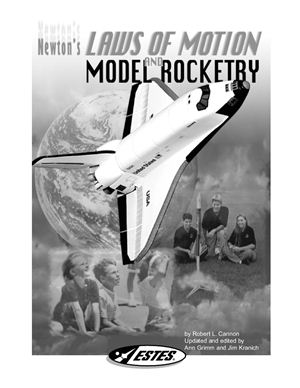Written by Robert L. Cannon. Updated and edited by Ann Grimm and
Jim Kranich. Estes Industries, 16 pages
Newton’s first law of motion: Objects at rest will stay at rest and objects in motion will stay in motion in a straight line unless acted upon by an unbalanced force.
- Why satellites stay in orbit
- Orbit producing forces
- Momentum
- Drag
- Inertia
- Simulation of orbital motion
- Review: Newton’s first law of motion
Newton’s second law of motion: Force is equal to mass times acceleration.
- Unbalanced forces and rockets
- Acceleration
- Momentum
- Thrust
- Multi-staged rockets
- Review: Newton’s second law of motion
Newton’s third law of motion: For every action there is an equal and opposite reaction.
- What rockets push against in space
- Review: Newton’s third law of motion
Review answers
Newton’s first law of motion: Objects at rest will stay at rest and objects in motion will stay in motion in a straight line unless acted upon by an unbalanced force.
- Why satellites stay in orbit
- Orbit producing forces
- Momentum
- Drag
- Inertia
- Simulation of orbital motion
- Review: Newton’s first law of motion
Newton’s second law of motion: Force is equal to mass times acceleration.
- Unbalanced forces and rockets
- Acceleration
- Momentum
- Thrust
- Multi-staged rockets
- Review: Newton’s second law of motion
Newton’s third law of motion: For every action there is an equal and opposite reaction.
- What rockets push against in space
- Review: Newton’s third law of motion
Review answers

